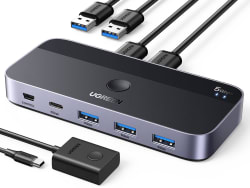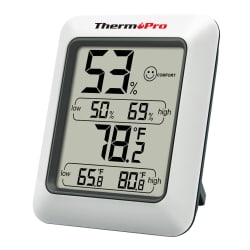Best Early Deals After Christmas 2024: Sales Now Live!

The holiday shopping season may start with Black Friday and Cyber Monday, but the great deals don't end once Christmas is over! If you aren't completely fatigued from months of savings events, After Christmas sales provide one more chance to scoop up big discounts.
And if you need to take back any lackluster gifts you receive, be sure to see every major store's holiday return policy now so you don't miss your return-window! Looking to treat yourself? There are plenty of Christmas gift card deals that are still live through the end of the year as well, so don't miss out!
Check out our guide below on what to expect from After Christmas sales in 2024.
Best Early Christmas Deals to Shop
Amazon Last-Minute Gift Deals
Up to 50% offAmazon always has your last-minute Christmas shopping covered, and this collection of deals puts it all in one place. Check the product page to see what delivers in time before Christmas, and Prime members should especially pay attention to products that will ship overnight with orders of $25 or more.
FLIR One Gen 3 Thermal Imaging Camera for iOS or Android
$150
That's the best price it's been.
Features:
- 1440x1080 visual, 80x60 thermal resolution
- Temperature range: 5°C to 120°C
- FLIR Ignite Cloud integration
Amazon Holiday Deals Sale
Up to 70% offShop deals on gifts, decor, stocking stuffers, and more during the Amazon Holiday sale. We found great prices on deals for the whole family.
Amazon Outlet Overstock Electronics Deals
Up to 60% offSave on thousands of items including headphones, speakers, batteries, cell phone accessories, and much more. We've pictured the Charmst 10,000mAh Portable Power Bank for $11 ($9 off).
Ugreen Chargers, Power Banks, Hubs, and Devices at Amazon
Up to 40% off + Prime SavingsSave on a range of cell phone chargers, power banks, USB-C hubs, Bluetooth devices, cables, and more. You'll find deals up to 40% off, plus several Prime-only offers. We've pictured the Ugreen 4-Port USB 3.0 Switch Hub for $39.99 w/ Prime ($6 off).
ThermoPro TP50 Digital Hygrometer & Thermometer
$9
That's the best price we could find by $3.
Features
- Air comfort indicator
- Accurate within +/-2 to 3%RH
- Data updates every 10 seconds
- High/low temperature records
- Three placement options
NOTE: The information below was compiled before After Christmas sales went into full swing. Please refer to the info above before making any shopping plans.
Historical Christmas Sale Overview
Check out the below sales we listed last year to get an idea of the types of After Christmas sales to expect in 2024. Look for sales with similar discounts from these retailers and others.
adidas: Take up to 60% off products for the whole family during the End of Year Sale at adidas. Find discounts on clothing, shoes, and accessories for men, women, and kids, and stock up on basics like socks as well.
Belk: Take up to 70% off end-of-season clearance items, including select beauty and fragrance products, clothing, shoes, accessories, bed and bath, and more.
Bloomingdale's: Want to save on designer goods? Consider shopping the After Christmas sale at Bloomingdale's, as you can save up to 65% off clothing, shoes, handbags, jewelry, home goods, and more.
IKEA: Whether you want affordable furniture to upgrade your current setup, need to get a jumpstart on your 'get organized' resolutions, or just want chic holiday decor, IKEA's Winter Sale is worth checking out. You'll save up to 70% off select seasonal decor, home textiles, kitchenware, and tableware — plus, up to 50% off other categories as well.
Macy's: Stock up on a variety of goods, including clothing, shoes, jewelry, handbags, home goods, bed and bath, and even toys (and more!). Discounts range from 20% to 60% off — plus, watch for extra savings via coupon codes on select items.
Nordstrom: Shop cozy picks for the whole family as well as select beauty items, shoes, and home goods for up to 50% off in the Nordstrom Half Yearly Sale. Plus save up to 70% off designer clearance products as well.
Target: Save up to 50% off in Target's Clearance Run event, with discounted categories including clothing, shoes, and accessories, as well as beauty and personal care, home items, sports and outdoors goods, and even toys. Plus, if you're looking for affordable holiday goods, now's the time to check out Target's deals on things like wrapping supplies, lights, seasonal candles, and more.
Walmart: This big-box retailer is also hosting a clearance event and taking up to 50% off a wide variety of categories. Shop items at particular price points, including:
- $5 and under
- $10 and under
- $25 and under
- $50 and under
- $100 and under
- $200 and under
If you're not worried about price categories, you can also shop by other specific product categories as well, such as Christmas decor, home items, clothing, shoes, beauty, toys, furniture, and much more.
Wayfair: Looking to change up your home space in the coming new year? Shop Wayfair's clearance event and save up to 60% on things like furniture and home decor, as well as other categories like bedding, lighting, and more. Plus, you can save up to 40% to 50% off other major categories as well.
Related DealNews Blog Posts:
- College can be costly, so save where you can by taking advantage of student discounts. Check out our guide on this year's top student discounts and save today.
- Senior discounts can be a significant perk as you get older. Learn what senior discounts are available starting at age 50 and how to track them.

Julie's work has been featured on CNBC, GoBankingRates, Kiplinger, Marketwatch, Money, The New York Times, Real Simple, US News, WaPo, WSJ, Yahoo!, and more. She's extolled the virtues of DealNews in interviews with Cheddar TV, GMA, various podcasts, and affiliates across the United States, plus one in Canada.







Sign In or Register